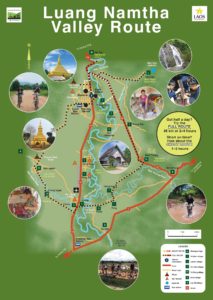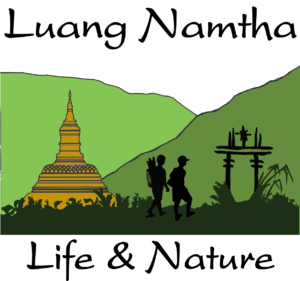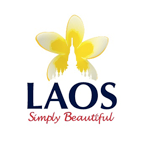The Luang Namtha Valley is one of the most ethnically diverse and culturally rich areas in Laos. Follow the Luang Namtha Valley Route to eight main ethnic villages and five cultural and religious sites, where you will discover aspects of daily life and culture and take in the scenic beauty of the Valley. The route is an excellent half-day self-guided trip. A short, 1–2 hours trip can also be made for those with less time.

How to Bike Around the Luang Namtha Valley Route
Rent a bicycle or motorbike from your guesthouse or hotel and head out on the Luang Namtha Valley Route. The Short and Full Routes described here are just a guide. You can make these trips as short or as long as you like, depending on how much you want to wonder around points of interest along the way!
Short Route (1 – 2hrs+)
From the middle of town head north stopping at the Museum for a quick insight into local culture. About 200m further on, turn left at the signs to That Luang Namtha. Follow this road for about 500m and turn right, climbing the steep hill past the beautiful new temple Wat Luang Namtha, to reach the Luang Namtha stupa. From here, ride back to the main road in town, turn left and head out of town on Route 3A. Keep going past the turn off to Ban Nam Dee for about 1.5km and turn right at the signs for Thong Jai Tai. Meander on the dirt road through this Tai Dam community before taking the bridge across the Nam Tha River back into Luang Namtha Town.
Full Route (2 – 4hrs+)
The first part is the same as for the Short Route. When heading out of town you can make a short detour to the Hmong village of Ban Hat Yao to see their unique style of embroidery. Otherwise head towards Ban Nam Dee Community Forest and Waterfall along a 5km bumpy dirt road. Here you can experience an ethnic Lanten village, take a short walk to a small waterfall and beyond through some really nice forest.
Retrace your way and either take the dirt road along to Thoung Dee village (dry season only) or take the main road (Route 3A) for about 4km to the sign-posted turn off to Nam Thoung. Enjoy a delightful ride through rice fields, Tai Dam villages and vegetable gardens as you make your way through to the Boat Landing, crossing the Nam Thoung River on a bamboo bridge along the way. You’ll get great views of the entire Namtha Valley.
After crossing the Nam Tha River near the Boat Landing (a good stop for food and drinks), you will meet the main road again for Luang Namtha Town. Look for the sign at the intersection to take a left turn onto the main road. After about 200m take a right turn back onto the dirt road to the Tai Daeng weaving village of Ban Phieng Ngam. Beautiful weaving is available for sale at the Phieng Ngam Handicraft Centre where you can also see weavers in action and get food and drinks.
After Phieng Ngam, head on towards the next village of Ban Nam Ngaen, about 2km along the road. Climb the stairway up to the hilltop stupa of Poum Pouk for great views over the valley. If you still have time, take the 1km side trip to the Akha village of Ban Nam Mut. Otherwise, follow the signs back into Luang Namtha Town via That Luang Namtha.
Stops Along the Way
1. Hat Yao Village is an ethnic Hmong village where you can see traditional Hmong embroidery and baskets being made by women around the village.
2. Nam Dee Village is an ethnic Lanten village where you can see cotton cloth dyed with indigo and production of natural bamboo paper, in addition tovisiting the community forest and waterfall.
3. Thong Jai Tai is an ethnic Tai Dam village where you can see weaving that is done using special, large looms and traditional alcohol production done by families.
4. Nam Thoung Village is an ethnic Tai Lue village known for vegetable production. You can check out what’s on sale at their local market and take a look at the village spirit post located nearby.
5. Sacred Forests and the Tai Dam Cemetery can be seen along the dirt road between Ban Poung to Ban Pasak. The colourful decorations of the women’s and men’s graves can be seen from the road.
6. Luang Khone Temple is located at Luang Village, an ethnic Kalom (Tai Yuan) village, and is the oldest Buddhist temple in the district.
7. Phieng Ngam Village is an ethnic Tai Daeng & Tai Khao village, which has a weaving center where you can learn about the weaving process, take a weaving or dying class or relax at the café.
8. Nam Ngaen Village is the largest ethnic Tai Dam village in the area and here you can visit the last professional traditional alcohol distillers and look around for silk and cotton weaving.
9. Nammat Mai Village is an ethnic Akha village, where you can see the spirits gate at the entrance (please do not touch!) and the traditional swing (used only during festivals) on the hill in the center of the village.
10. Poum Pouk Stupa was originally constructed in 1628 to demarcate neutral territory between the Kingdoms of Lane Xang in Luang Prabang and Lan Na in Chiang Mai.
11. Vieng Neua Village is an ethnic Tai Yuan (Kalom) village, which is considered the oldest ethnic group in the Valley and practices a mix of Buddhism and animism. Here you can see the village spirit post, the district spirit post and the new Vieng Neua Buddhist temple.
12. Vieng Neua Kao Temple is the old temple of Vieng Neua Village, before the village moved across the main road to make room for the extension of the airport. The old temple is still used by the village and is a peaceful place to visit.
13.Luang Namtha Stupa is perched on the mountain overlooking Luang Namtha Town, just a short walk from the main street. Sunset and sunrise is a good time to visit.

